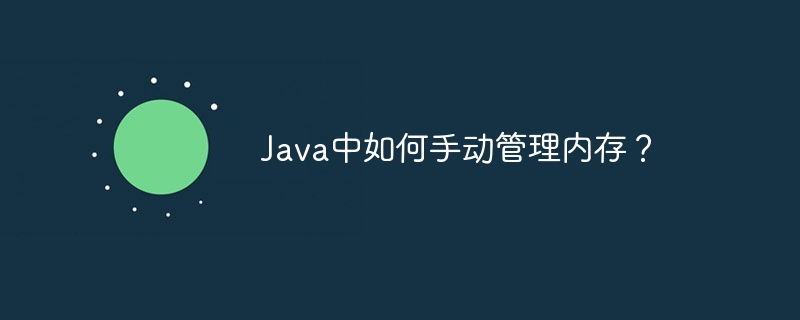How to manually manage memory in Java?
Manual memory management techniques in Java include: Reference counting: Tracks the number of references to an object, and releases object memory when the reference count reaches 0. Weak reference: A special reference type that does not prevent the object from being recycled when the garbage collector reclaims the object. Strong references: Ensure that an object will not be garbage collected, even if it is no longer needed.

Manual Memory Management in Java
Introduction
Java is a Automatic garbage collection languages usually do not require manual memory management. However, in some cases, manually managing memory can provide performance benefits or increased control over memory usage.
Reference Counting
Reference counting is a manual memory management technique that keeps track of the number of references each object has. When the reference count drops to 0, the object will be garbage collected. For example:
// 创建一个对象并将其存储在引用变量中
String myString = new String("Hello World");
// 获得对该对象的另一个引用
String anotherString = myString;
// 释放 myString 对该对象的引用
myString = null;
// 此时引用计数为 1(anotherString)Weak reference
Weak reference is a special reference type that does not prevent the object from being recycled when the garbage collector reclaims it. For example:
// 创建一个弱引用 WeakReference<String> weakReference = new WeakReference<>(myString); // 释放对该对象的最后一个强引用 myString = null; // 此时 weakReference 仍然引用该对象,但该对象可以被垃圾回收
Practical case
Using soft references to cache images
Soft references can be used to cache images. When memory is low, soft reference objects can be garbage collected without reloading the image.
// 创建一个软引用缓存
Map<String, SoftReference<Image>> imageCache = new HashMap<>();
// 获取图像
Image image = getImage(url);
// 将图像添加到缓存中
imageCache.put(url, new SoftReference<>(image));
// 获取图像
Image cachedImage = imageCache.get(url).get();
// 如果 cachedImage 为 null,则重新加载图像
if (cachedImage == null) {
cachedImage = getImage(url);
}Use strong references to prevent objects from being garbage collected
Strong references ensure that an object will not be garbage collected, even if it is no longer needed. For example, in the singleton pattern, use a strong reference to ensure that only one instance is created.
// 创建单例的私有构造函数
private Singleton() { }
// 创建一个强引用
private static final Singleton INSTANCE = new Singleton();
// 获取单例实例
public static Singleton getInstance() {
return INSTANCE;
}Note: Manual memory management should be used with caution as it may cause memory leaks or other problems. In most cases, automatic garbage collection is sufficient for Java applications.
The above is the detailed content of How to manually manage memory in Java?. For more information, please follow other related articles on the PHP Chinese website!

Hot AI Tools

Undresser.AI Undress
AI-powered app for creating realistic nude photos

AI Clothes Remover
Online AI tool for removing clothes from photos.

Undress AI Tool
Undress images for free

Clothoff.io
AI clothes remover

AI Hentai Generator
Generate AI Hentai for free.

Hot Article

Hot Tools

Notepad++7.3.1
Easy-to-use and free code editor

SublimeText3 Chinese version
Chinese version, very easy to use

Zend Studio 13.0.1
Powerful PHP integrated development environment

Dreamweaver CS6
Visual web development tools

SublimeText3 Mac version
God-level code editing software (SublimeText3)

Hot Topics
 Square Root in Java
Aug 30, 2024 pm 04:26 PM
Square Root in Java
Aug 30, 2024 pm 04:26 PM
Guide to Square Root in Java. Here we discuss how Square Root works in Java with example and its code implementation respectively.
 Perfect Number in Java
Aug 30, 2024 pm 04:28 PM
Perfect Number in Java
Aug 30, 2024 pm 04:28 PM
Guide to Perfect Number in Java. Here we discuss the Definition, How to check Perfect number in Java?, examples with code implementation.
 Random Number Generator in Java
Aug 30, 2024 pm 04:27 PM
Random Number Generator in Java
Aug 30, 2024 pm 04:27 PM
Guide to Random Number Generator in Java. Here we discuss Functions in Java with examples and two different Generators with ther examples.
 Weka in Java
Aug 30, 2024 pm 04:28 PM
Weka in Java
Aug 30, 2024 pm 04:28 PM
Guide to Weka in Java. Here we discuss the Introduction, how to use weka java, the type of platform, and advantages with examples.
 Armstrong Number in Java
Aug 30, 2024 pm 04:26 PM
Armstrong Number in Java
Aug 30, 2024 pm 04:26 PM
Guide to the Armstrong Number in Java. Here we discuss an introduction to Armstrong's number in java along with some of the code.
 Smith Number in Java
Aug 30, 2024 pm 04:28 PM
Smith Number in Java
Aug 30, 2024 pm 04:28 PM
Guide to Smith Number in Java. Here we discuss the Definition, How to check smith number in Java? example with code implementation.
 Java Spring Interview Questions
Aug 30, 2024 pm 04:29 PM
Java Spring Interview Questions
Aug 30, 2024 pm 04:29 PM
In this article, we have kept the most asked Java Spring Interview Questions with their detailed answers. So that you can crack the interview.
 Break or return from Java 8 stream forEach?
Feb 07, 2025 pm 12:09 PM
Break or return from Java 8 stream forEach?
Feb 07, 2025 pm 12:09 PM
Java 8 introduces the Stream API, providing a powerful and expressive way to process data collections. However, a common question when using Stream is: How to break or return from a forEach operation? Traditional loops allow for early interruption or return, but Stream's forEach method does not directly support this method. This article will explain the reasons and explore alternative methods for implementing premature termination in Stream processing systems. Further reading: Java Stream API improvements Understand Stream forEach The forEach method is a terminal operation that performs one operation on each element in the Stream. Its design intention is






